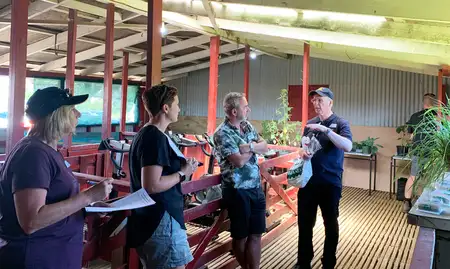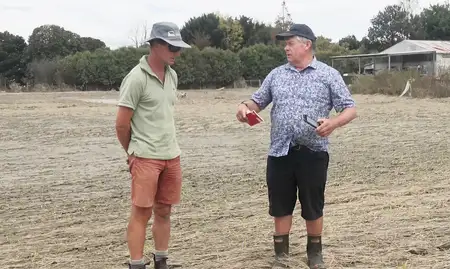
Central Hawke’s Bay farmers accompanied Dr Ranvir Singh during site visits in the catchment.
Farmers in the Kahahakuri catchment have collaborated with Hawke's Bay catchment collective Tukituki Land Care (TLC) to address issues of cow cress and stream bank erosion, which are impacting waterways in the catchment.
Following site visits and the engagement of experts from across Aotearoa New Zealand, a recent presentation at the Ongaonga Community Hall unveiled findings and charted a course of action.
Local farmer and chair of the Kahahakuri Catchment Group Andy Gunson says, “We are looking for effective solutions to protect our waterways. We are keen to hear from anyone who is dealing with cow cress on their properties so we can understand the extent of the problem across the wider Tukituki catchment."
Cow cress, also known as water celery, is an invasive species similar to watercress, but with a larger leaf and an unpleasant bitter taste. It is identified as a pervasive threat across the catchment, encroaching upon tributaries and streams. Farmers are concerned about its adverse effects on stream health and the heightened risk of flooding and damage due to the bulk of the weed.
It is understood that cow cress arrived in the catchment about eight years ago, but over the last five years local farmers have observed a concerning proliferation, likely caused by milder winters, legislation around the fencing of waterways and elevated nitrogen.
Bank erosion and shingle accumulation have also emerged as significant challenges, leading to rapid land loss in areas of the catchment. The severity of the erosion, evident from aerial photos and LiDAR analysis, underscores the urgency of considered management to safeguard agricultural lands and water resources.
To address these concerns, the Kahahakuri catchment group secured a grant from TLC to investigate the best course of action to control cow cress and mitigate erosion. TLC is working closely with the catchment on this project and has partnered with Access to Experts (A2E), a complimentary service established by the Ministry for Environment which facilitates connections between catchment groups and freshwater specialists.
A2E provides 42 hours of assistance dedicated to the project, through the advice of Te Kunenga ki Pūrehuroa Massey University experts Associate Professor Ranvir Singh and Professor Ian Fuller.
Dr Singh and Professor Fuller have visited farms in the catchment to see the extent of the issues and come up with a proactive management plan. At a recent presentation in Ongaonga, farmers were invited to hear from the Massey experts, alongside Richard Frizzell from Nelson City Council, who shared insights from his ongoing endeavours to combat cow cress in the Nelson area.

Dr Ranvir Singh presenting to farmers in Ongaonga.
Professor Fuller, who has been investigating erosion in the catchment, went back to basics, looking at the nature of the water channel to help explain why imbalances in the system are leading to erosion. The stream in some places is deeply entrenched and is both cutting down and migrating laterally. Bank protection, riparian planting and rock riffles as a means to counteract erosion are less likely to cope with the power of flood water in constrained channels.
Instead, he suggested the stream be considered at a catchment level and the system mapped in detail to show critical zones and priority areas.
The battle with cow cress is likely to be a long-term effort requiring a combination of chemical and riparian control methods.
Dr Singh says the spread of cow cress appeared abundant in the visited farm drains and streams.
“Cow cress appears to favour nutrient-rich environments but is intolerant to dense shading. A coordinated and consistent effort with tools such as targeted spraying, riparian planting, and mitigation of nutrient losses should help reduce and manage its growth in the streams."
He also presented several novel edge-of-field nutrient loss mitigation practices to the group including managed drainage, woodchip bioreactor and runoff detainment bunds.
To find out more about this project and how Tukituki Land Care is supporting other Tukituki sub-catchment groups, go to www.tukitukilandcare.org.
Story courtesy of Tukituki Land Care.
Related news
Partnering to encourage young people into the primary industries
Encouraging high school students to pursue a career in the primary industries was the aim of a recent educational day with a group of North Island high school teachers.

Helping Hawke’s Bay growers recover from Cyclone Gabrielle
Staff from Massey’s Farmed Landscapes Research Centre were part of recovery efforts following the devastation caused by the Cyclone.
